873 lines
25 KiB
Markdown
873 lines
25 KiB
Markdown
|
|
\mainpage
|
|||
|
|
|
|||
|
|
# Introduction {#introduction}
|
|||
|
|
|
|||
|
|
Welcome to the FTXUI documentation!
|
|||
|
|
|
|||
|
|
This is a brief tutorial. You are also encouraged to self-learn by reading the
|
|||
|
|
[examples](./examples.html).
|
|||
|
|
|
|||
|
|
@tableofcontents
|
|||
|
|
|
|||
|
|
**Short example**
|
|||
|
|
|
|||
|
|
To build a single frame, you need create an `ftxui::Element`, and display it on
|
|||
|
|
a `ftxui::Screen`.
|
|||
|
|
|
|||
|
|
**main.cpp**
|
|||
|
|
```cpp
|
|||
|
|
#include <ftxui/dom/elements.hpp>
|
|||
|
|
#include <ftxui/screen/screen.hpp>
|
|||
|
|
#include <iostream>
|
|||
|
|
|
|||
|
|
int main(void) {
|
|||
|
|
using namespace ftxui;
|
|||
|
|
|
|||
|
|
// Define the document
|
|||
|
|
Element document =
|
|||
|
|
hbox({
|
|||
|
|
text("left") | border,
|
|||
|
|
text("middle") | border | flex,
|
|||
|
|
text("right") | border,
|
|||
|
|
});
|
|||
|
|
|
|||
|
|
auto screen = Screen::Create(
|
|||
|
|
Dimension::Full(), // Width
|
|||
|
|
Dimension::Fit(document) // Height
|
|||
|
|
);
|
|||
|
|
Render(screen, document);
|
|||
|
|
screen.Print();
|
|||
|
|
|
|||
|
|
return EXIT_SUCCESS;
|
|||
|
|
}
|
|||
|
|
```
|
|||
|
|
|
|||
|
|
|
|||
|
|
**output**
|
|||
|
|
```bash
|
|||
|
|
┌────┐┌────────────────────────────────────┐┌─────┐
|
|||
|
|
│left││middle ││right│
|
|||
|
|
└────┘└────────────────────────────────────┘└─────┘
|
|||
|
|
```
|
|||
|
|
|
|||
|
|
# Build {#build}
|
|||
|
|
|
|||
|
|
## Using CMake {#build-cmake}
|
|||
|
|
|
|||
|
|
This is an example configuration for your **CMakeLists.txt**
|
|||
|
|
|
|||
|
|
CMakeLists.txt
|
|||
|
|
```cmake
|
|||
|
|
cmake_minimum_required (VERSION 3.11)
|
|||
|
|
|
|||
|
|
# --- Fetch FTXUI --------------------------------------------------------------
|
|||
|
|
include(FetchContent)
|
|||
|
|
|
|||
|
|
set(FETCHCONTENT_UPDATES_DISCONNECTED TRUE)
|
|||
|
|
FetchContent_Declare(ftxui
|
|||
|
|
GIT_REPOSITORY https://github.com/ArthurSonzogni/ftxui
|
|||
|
|
# Important: Specify a GIT_TAG XXXXX here.
|
|||
|
|
)
|
|||
|
|
|
|||
|
|
FetchContent_GetProperties(ftxui)
|
|||
|
|
if(NOT ftxui_POPULATED)
|
|||
|
|
FetchContent_Populate(ftxui)
|
|||
|
|
add_subdirectory(${ftxui_SOURCE_DIR} ${ftxui_BINARY_DIR} EXCLUDE_FROM_ALL)
|
|||
|
|
endif()
|
|||
|
|
|
|||
|
|
# ------------------------------------------------------------------------------
|
|||
|
|
|
|||
|
|
project(ftxui-starter
|
|||
|
|
LANGUAGES CXX
|
|||
|
|
VERSION 1.0.0
|
|||
|
|
)
|
|||
|
|
|
|||
|
|
add_executable(ftxui-starter src/main.cpp)
|
|||
|
|
target_include_directories(ftxui-starter PRIVATE src)
|
|||
|
|
|
|||
|
|
target_link_libraries(ftxui-starter
|
|||
|
|
PRIVATE ftxui::screen
|
|||
|
|
PRIVATE ftxui::dom
|
|||
|
|
PRIVATE ftxui::component # Not needed for this example.
|
|||
|
|
)
|
|||
|
|
|
|||
|
|
```
|
|||
|
|
|
|||
|
|
Subsequently, you build the project in the standard fashion as follows:
|
|||
|
|
```bash
|
|||
|
|
mkdir build && cd build
|
|||
|
|
cmake ..
|
|||
|
|
make
|
|||
|
|
./main
|
|||
|
|
```
|
|||
|
|
|
|||
|
|
# List of modules. {#modules}
|
|||
|
|
|
|||
|
|
The project is comprised of 3 modules:
|
|||
|
|
|
|||
|
|
1. **ftxui/screen** defines a `ftxui::Screen`, a grid of `ftxui::Pixel`.
|
|||
|
|
|
|||
|
|
2. **ftxui/dom** is the main module. It defines a hierarchical set of
|
|||
|
|
`ftxui::Element`. An element draws something on the `ftxui::Screen`. It is
|
|||
|
|
responsive to the size of its container.
|
|||
|
|
|
|||
|
|
3. **ftxui/component** The module is required if your program needs to respond
|
|||
|
|
to user input. It defines a set of `ftxui::Component`. These components can
|
|||
|
|
be utilized to navigate using the arrow keys *and/or* cursor. There are
|
|||
|
|
several builtin widgets like checkbox/inputbox/etc to interact with. You can
|
|||
|
|
combine them, or even define your own custom components.
|
|||
|
|
|
|||
|
|
# screen {#module-screen}
|
|||
|
|
|
|||
|
|
This is the visual element of the program. It defines a `ftxui::Screen`, which
|
|||
|
|
is a grid of `ftxui::Pixel`. A Pixel represents a Unicode character and its
|
|||
|
|
associated style (bold, colors, etc.). The screen can be printed as a string
|
|||
|
|
using `ftxui::Screen::ToString()`. The following example highlights this
|
|||
|
|
process:
|
|||
|
|
|
|||
|
|
```cpp
|
|||
|
|
#include <ftxui/screen/screen.hpp>
|
|||
|
|
#include <iostream>
|
|||
|
|
|
|||
|
|
int main(void) {
|
|||
|
|
using namespace ftxui;
|
|||
|
|
auto screen = Screen::Create(Dimension::Fixed(32), Dimension::Fixed(10));
|
|||
|
|
|
|||
|
|
auto& pixel = screen.PixelAt(9,9);
|
|||
|
|
pixel.character = U'A';
|
|||
|
|
pixel.bold = true;
|
|||
|
|
pixel.foreground_color = Color::Blue;
|
|||
|
|
|
|||
|
|
std::cout << screen.ToString();
|
|||
|
|
return EXIT_SUCCESS;
|
|||
|
|
}
|
|||
|
|
```
|
|||
|
|
|
|||
|
|
# dom {#module-dom}
|
|||
|
|
|
|||
|
|
This module defines a hierarchical set of `ftxui::Element`. An element manages
|
|||
|
|
the layout and can be responsive to the terminal dimension changes. Note the
|
|||
|
|
following example where this module is used to create a simple layout with a
|
|||
|
|
number of operators:
|
|||
|
|
|
|||
|
|
**Example:**
|
|||
|
|
```cpp
|
|||
|
|
// Define the document
|
|||
|
|
Element document = vbox({
|
|||
|
|
text("The window") | bold | color(Color::Blue),
|
|||
|
|
gauge(0.5)
|
|||
|
|
text("The footer")
|
|||
|
|
});
|
|||
|
|
|
|||
|
|
// Add a border, by calling the `ftxui::border` decorator function.
|
|||
|
|
document = border(document);
|
|||
|
|
|
|||
|
|
// Add another border, using the pipe operator.
|
|||
|
|
document = document | border.
|
|||
|
|
|
|||
|
|
// Add another border, using the |= operator.
|
|||
|
|
document |= border
|
|||
|
|
|
|||
|
|
```
|
|||
|
|
|
|||
|
|
**List of elements**
|
|||
|
|
|
|||
|
|
The list of all elements are included and can be accessed by including the
|
|||
|
|
corresponding header file:
|
|||
|
|
```cpp
|
|||
|
|
#include <ftxui/dom/elements.hpp>
|
|||
|
|
```
|
|||
|
|
|
|||
|
|
\include ftxui/dom/elements.hpp
|
|||
|
|
|
|||
|
|
## text ## {#dom-text}
|
|||
|
|
|
|||
|
|
The most simple widget. It displays a text.
|
|||
|
|
```cpp
|
|||
|
|
text("I am a piece of text");
|
|||
|
|
```
|
|||
|
|
```bash
|
|||
|
|
I am a piece of text.
|
|||
|
|
```
|
|||
|
|
|
|||
|
|
## vtext {#dom-vtext}
|
|||
|
|
|
|||
|
|
Identical to `ftxui::text`, but displayed vertically.
|
|||
|
|
|
|||
|
|
Code:
|
|||
|
|
```cpp
|
|||
|
|
vtext("HELLO");
|
|||
|
|
```
|
|||
|
|
|
|||
|
|
Terminal output:
|
|||
|
|
```bash
|
|||
|
|
H
|
|||
|
|
E
|
|||
|
|
L
|
|||
|
|
L
|
|||
|
|
O
|
|||
|
|
```
|
|||
|
|
|
|||
|
|
## paragraph {#dom-paragraph}
|
|||
|
|
|
|||
|
|
Similar to `ftxui::text`, but the individual word are wrapped along multiple
|
|||
|
|
lines, depending on the width of its container.
|
|||
|
|
|
|||
|
|
Sample Code:
|
|||
|
|
```cpp
|
|||
|
|
paragraph("A very long text")
|
|||
|
|
```
|
|||
|
|
|
|||
|
|
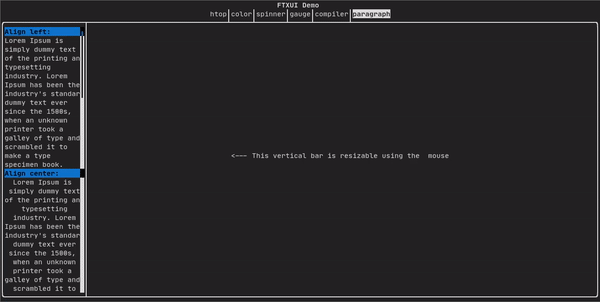
|
|||
|
|
|
|||
|
|
For a more detailed example refer to [detailed example](https://arthursonzogni.github.io/FTXUI/examples_2dom_2paragraph_8cpp-example.html). Paragraph also includes a number of other variants as shown below:
|
|||
|
|
```cpp
|
|||
|
|
Element paragraph(std::string text);
|
|||
|
|
Element paragraphAlignLeft(std::string text);
|
|||
|
|
Element paragraphAlignRight(std::string text);
|
|||
|
|
Element paragraphAlignCenter(std::string text);
|
|||
|
|
Element paragraphAlignJustify(std::string text);
|
|||
|
|
```
|
|||
|
|
|
|||
|
|
|
|||
|
|
## border {#dom-border}
|
|||
|
|
|
|||
|
|
Adds a border around an element.
|
|||
|
|
|
|||
|
|
Code:
|
|||
|
|
```cpp
|
|||
|
|
border(text("The element"))
|
|||
|
|
```
|
|||
|
|
|
|||
|
|
Terminal output:
|
|||
|
|
```bash
|
|||
|
|
┌───────────┐
|
|||
|
|
│The element│
|
|||
|
|
└───────────┘
|
|||
|
|
```
|
|||
|
|
|
|||
|
|
You can achieve the same behavior by using the pipe operator.
|
|||
|
|
|
|||
|
|
Code:
|
|||
|
|
```cpp
|
|||
|
|
text("The element") | border
|
|||
|
|
```
|
|||
|
|
|
|||
|
|
Border also comes in a variety of styles as shown below:
|
|||
|
|
```cpp
|
|||
|
|
Element border(Element);
|
|||
|
|
Element borderLight(Element);
|
|||
|
|
Element borderHeavy(Element);
|
|||
|
|
Element borderDouble(Element);
|
|||
|
|
Element borderRounded(Element);
|
|||
|
|
Element borderEmpty(Element);
|
|||
|
|
Decorator borderStyled(BorderStyle);
|
|||
|
|
Decorator borderWith(Pixel);
|
|||
|
|
```
|
|||
|
|
|
|||
|
|
|
|||
|
|
## window ## {#dom-window}
|
|||
|
|
|
|||
|
|
A `ftxui::window` is a `ftxui::border`, but with an additional header. To add a
|
|||
|
|
window around an element, wrap it and specify a string as the header.
|
|||
|
|
Code:
|
|||
|
|
```cpp
|
|||
|
|
window("The window", text("The element"))
|
|||
|
|
```
|
|||
|
|
|
|||
|
|
Terminal output:
|
|||
|
|
```bash
|
|||
|
|
┌The window─┐
|
|||
|
|
│The element│
|
|||
|
|
└───────────┘
|
|||
|
|
```
|
|||
|
|
|
|||
|
|
## separator {#dom-separator}
|
|||
|
|
|
|||
|
|
Displays a vertical/horizontal line to visually split the content of a
|
|||
|
|
container in two.
|
|||
|
|
|
|||
|
|
Code:
|
|||
|
|
```cpp
|
|||
|
|
border(
|
|||
|
|
hbox({
|
|||
|
|
text("Left"),
|
|||
|
|
separator(),
|
|||
|
|
text("Right")
|
|||
|
|
})
|
|||
|
|
)
|
|||
|
|
```
|
|||
|
|
|
|||
|
|
Terminal output:
|
|||
|
|
```bash
|
|||
|
|
┌────┬─────┐
|
|||
|
|
│left│right│
|
|||
|
|
└────┴─────┘
|
|||
|
|
```
|
|||
|
|
|
|||
|
|
|
|||
|
|
Separators come in a variety of flavors as shown below:
|
|||
|
|
```cpp
|
|||
|
|
Element separator(void);
|
|||
|
|
Element separatorLight();
|
|||
|
|
Element separatorHeavy();
|
|||
|
|
Element separatorDouble();
|
|||
|
|
Element separatorEmpty();
|
|||
|
|
Element separatorStyled(BorderStyle);
|
|||
|
|
Element separator(Pixel);
|
|||
|
|
Element separatorCharacter(std::string);
|
|||
|
|
Element separatorHSelector(float left,
|
|||
|
|
float right,
|
|||
|
|
Color background,
|
|||
|
|
Color foreground);
|
|||
|
|
Element separatorVSelector(float up,
|
|||
|
|
float down,
|
|||
|
|
Color background,
|
|||
|
|
Color foreground);
|
|||
|
|
```
|
|||
|
|
|
|||
|
|
## gauge {#dom-gauge}
|
|||
|
|
|
|||
|
|
It constitutes a gauge. It can be used to represent a progress bar.
|
|||
|
|
|
|||
|
|
Code:
|
|||
|
|
```cpp
|
|||
|
|
border(gauge(0.5))
|
|||
|
|
```
|
|||
|
|
|
|||
|
|
Teminal output:
|
|||
|
|
```bash
|
|||
|
|
┌────────────────────────────────────────────────────────────────────────────┐
|
|||
|
|
│██████████████████████████████████████ │
|
|||
|
|
└────────────────────────────────────────────────────────────────────────────┘
|
|||
|
|
```
|
|||
|
|
|
|||
|
|
Gauges can be displayed in many orientations as shown below:
|
|||
|
|
```cpp
|
|||
|
|
Element gauge(float ratio);
|
|||
|
|
Element gaugeLeft(float ratio);
|
|||
|
|
Element gaugeRight(float ratio);
|
|||
|
|
Element gaugeUp(float ratio);
|
|||
|
|
Element gaugeDown(float ratio);
|
|||
|
|
Element gaugeDirection(float ratio, GaugeDirection);
|
|||
|
|
```
|
|||
|
|
|
|||
|
|
## graph {#dom-graph}
|
|||
|
|
|
|||
|
|
@htmlonly
|
|||
|
|
<script id="asciicast-223726" src="https://asciinema.org/a/223726.js" async></script>
|
|||
|
|
@endhtmlonly
|
|||
|
|
|
|||
|
|
See:
|
|||
|
|
```cpp
|
|||
|
|
Element graph(GraphFunction);
|
|||
|
|
```
|
|||
|
|
|
|||
|
|
## Colors {#dom-colors}
|
|||
|
|
|
|||
|
|
Most terminal consoles can display colored text and colored backgrounds. FTXUI
|
|||
|
|
supports every color palette:
|
|||
|
|
```cpp
|
|||
|
|
Decorator color(Color);
|
|||
|
|
Decorator bgcolor(Color);
|
|||
|
|
```
|
|||
|
|
|
|||
|
|
|
|||
|
|
Color [gallery](https://arthursonzogni.github.io/FTXUI/examples_2dom_2color_gallery_8cpp-example.html):
|
|||
|
|
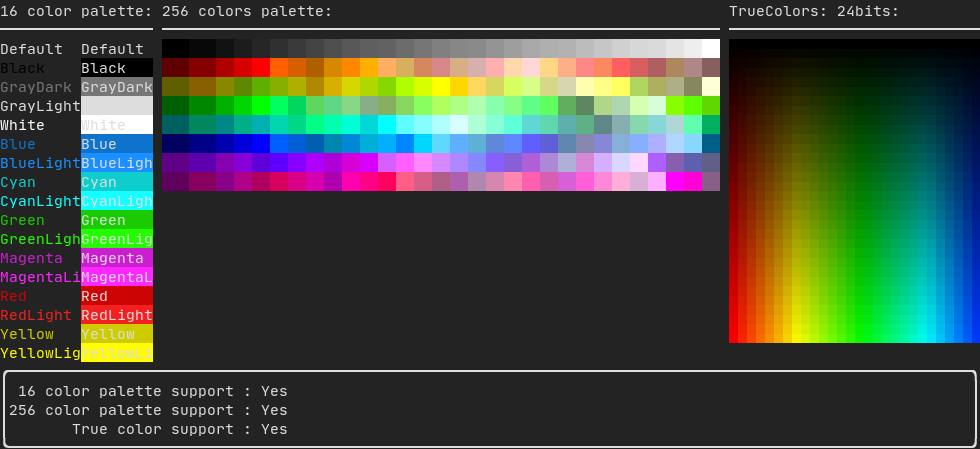
|
|||
|
|
|
|||
|
|
### Palette16 #{#dom-colors-palette-16}
|
|||
|
|
|
|||
|
|
On most terminals the following colors are supported:
|
|||
|
|
- Default
|
|||
|
|
|
|||
|
|
- Black
|
|||
|
|
- GrayDark
|
|||
|
|
- GrayLight
|
|||
|
|
|
|||
|
|
- White
|
|||
|
|
|
|||
|
|
- Blue
|
|||
|
|
- BlueLight
|
|||
|
|
|
|||
|
|
- Cyan
|
|||
|
|
- CyanLight
|
|||
|
|
|
|||
|
|
- Green
|
|||
|
|
- GreenLight
|
|||
|
|
|
|||
|
|
- Magenta
|
|||
|
|
- MagentaLight
|
|||
|
|
|
|||
|
|
- Red
|
|||
|
|
- RedLight
|
|||
|
|
|
|||
|
|
- Yellow
|
|||
|
|
- YellowLight
|
|||
|
|
|
|||
|
|
Example use of the above colors using the pipe operator:
|
|||
|
|
```cpp
|
|||
|
|
text("Blue foreground") | color(Color::Blue);
|
|||
|
|
text("Blue background") | bgcolor(Color::Blue);
|
|||
|
|
text("Black on white") | color(Color::Black) | bgcolor(Color::White);
|
|||
|
|
```
|
|||
|
|
|
|||
|
|
### Palette256 #{#dom-colors-palette-256}
|
|||
|
|
|
|||
|
|
On terminal supporting 256 colors.
|
|||
|
|
@htmlonly
|
|||
|
|
<script id="asciicast-OAUc3n6QrkmrLt7XEEb8AzbLt" src="https://asciinema.org/a/OAUc3n6QrkmrLt7XEEb8AzbLt.js" async></script>
|
|||
|
|
@endhtmlonly
|
|||
|
|
|
|||
|
|
```cpp
|
|||
|
|
text("HotPink") | color(Color::HotPink);
|
|||
|
|
```
|
|||
|
|
|
|||
|
|
### TrueColor #{#dom-colors-true-color}
|
|||
|
|
|
|||
|
|
On terminal supporting trueColor, you can directly use the 24bit RGB color
|
|||
|
|
space:
|
|||
|
|
|
|||
|
|
Use the constructors below to specify the **RGB** or **HSV** values for your
|
|||
|
|
color:
|
|||
|
|
|
|||
|
|
There are two constructors:
|
|||
|
|
```cpp
|
|||
|
|
ftxui::Color::RGB(uint8_t red, uint8_t green, uint8_t blue);
|
|||
|
|
ftxui::Color::HSV(uint8_t hue, uint8_t saturation, uint8_t value);
|
|||
|
|
```
|
|||
|
|
|
|||
|
|
@htmlonly
|
|||
|
|
<script id="asciicast-dk5r8IcCH0aFIIgWG0keSEHMG" src="https://asciinema.org/a/dk5r8IcCH0aFIIgWG0keSEHMG.js" async></script>
|
|||
|
|
<script id="asciicast-xwzzghmqcqzIuyLwCpQFEqbEu" src="https://asciinema.org/a/xwzzghmqcqzIuyLwCpQFEqbEu.js" async></script>
|
|||
|
|
@endhtmlonly
|
|||
|
|
|
|||
|
|
## LinearGradient #{#dom-linear-gradient}
|
|||
|
|
|
|||
|
|
FTXUI supports linear gradient. Either on the foreground or the background.
|
|||
|
|
|
|||
|
|
```cpp
|
|||
|
|
Decorator color(const LinearGradient&);
|
|||
|
|
Decorator bgcolor(const LinearGradient&);
|
|||
|
|
```
|
|||
|
|
|
|||
|
|
A `ftxui::LinearGradient` is defined by an angle in degree, and a list of color
|
|||
|
|
stops.
|
|||
|
|
```cpp
|
|||
|
|
auto gradient = LinearGradient()
|
|||
|
|
.Angle(45)
|
|||
|
|
.AddStop(0.0, Color::Red)
|
|||
|
|
.AddStop(0.5, Color::Green)
|
|||
|
|
.AddStop(1.0, Color::Blue);
|
|||
|
|
```
|
|||
|
|
|
|||
|
|
You can also use simplified constructors:
|
|||
|
|
```cpp
|
|||
|
|
LinearGradient(Color::Red, Color::Blue);
|
|||
|
|
```
|
|||
|
|
```cpp
|
|||
|
|
LinearGradient(45, Color::Red, Color::Blue);
|
|||
|
|
```
|
|||
|
|
|
|||
|
|
See [demo](https://arthursonzogni.github.io/FTXUI/examples/?file=component/linear_gradient_gallery).
|
|||
|
|
|
|||
|
|
|
|||
|
|
## Style {#dom-style}
|
|||
|
|
In addition to colored text and colored backgrounds. Many terminals support text
|
|||
|
|
effects such as: `bold`, `dim`, `underlined`, `inverted`, `blink`.
|
|||
|
|
|
|||
|
|
```cpp
|
|||
|
|
Element bold(Element);
|
|||
|
|
Element dim(Element);
|
|||
|
|
Element inverted(Element);
|
|||
|
|
Element underlined(Element);
|
|||
|
|
Element underlinedDouble(Element);
|
|||
|
|
Element strikethrough(Element);
|
|||
|
|
Element blink(Element);
|
|||
|
|
Decorator color(Color);
|
|||
|
|
Decorator bgcolor(Color);
|
|||
|
|
Decorator colorgrad(LinearGradient);
|
|||
|
|
Decorator bgcolorgrad(LinearGradient);
|
|||
|
|
```
|
|||
|
|
|
|||
|
|
[Example](https://arthursonzogni.github.io/FTXUI/examples_2dom_2style_gallery_8cpp-example.html)
|
|||
|
|
|
|||
|
|

|
|||
|
|
|
|||
|
|
To use these effects, simply wrap your elements with your desired effect:
|
|||
|
|
```cpp
|
|||
|
|
underlined(bold(text("This text is bold and underlined")))
|
|||
|
|
```
|
|||
|
|
|
|||
|
|
Alternatively, use the pipe operator to chain it on your element:
|
|||
|
|
```cpp
|
|||
|
|
text("This text is bold") | bold | underlined
|
|||
|
|
```
|
|||
|
|
|
|||
|
|
## Layout {#dom-layout}
|
|||
|
|
|
|||
|
|
Enables elements to be arranged in the following ways:
|
|||
|
|
- **Horizontally** with `ftxui::hbox`
|
|||
|
|
- **Vertically** with `ftxui::vbox`
|
|||
|
|
- **Inside a grid** with `ftxui::gridbox`
|
|||
|
|
- **Wrapped along one direction** using the `ftxui::flexbox`.
|
|||
|
|
|
|||
|
|
[Example](https://arthursonzogni.github.io/FTXUI/examples_2dom_2vbox_hbox_8cpp-example.html) using `ftxui::hbox`, `ftxui::vbox` and `ftxui::filler`.
|
|||
|
|
|
|||
|
|
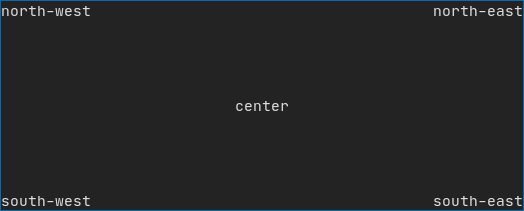
|
|||
|
|
|
|||
|
|
|
|||
|
|
[Example](https://arthursonzogni.github.io/FTXUI/examples_2dom_2gridbox_8cpp-example.htmlp)
|
|||
|
|
using `ftxui::gridbox`:
|
|||
|
|
|
|||
|
|
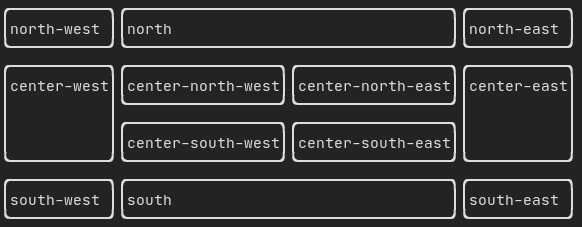
|
|||
|
|
|
|||
|
|
[Example](https://github.com/ArthurSonzogni/FTXUI/blob/master/examples/dom/hflow.cpp)
|
|||
|
|
using flexbox:
|
|||
|
|
|
|||
|
|
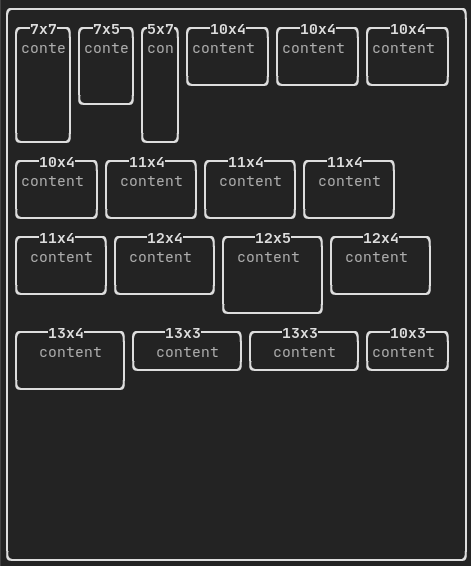
|
|||
|
|
|
|||
|
|
Checkout this
|
|||
|
|
[example](https://arthursonzogni.github.io/FTXUI/examples_2dom_2hflow_8cpp-example.html)
|
|||
|
|
and the associated
|
|||
|
|
[demo](https://arthursonzogni.github.io/FTXUI/examples/?file=component/flexbox).
|
|||
|
|
|
|||
|
|
Element can also become flexible using the the `ftxui::flex` decorator.
|
|||
|
|
|
|||
|
|
Code:
|
|||
|
|
```cpp
|
|||
|
|
hbox({
|
|||
|
|
text("left") | border ,
|
|||
|
|
text("middle") | border | flex,
|
|||
|
|
text("right") | border,
|
|||
|
|
});
|
|||
|
|
```
|
|||
|
|
Terminal output:
|
|||
|
|
```bash
|
|||
|
|
┌────┐┌─────────────────────────────────────────────────────┐┌─────┐
|
|||
|
|
│left││middle ││right│
|
|||
|
|
└────┘└─────────────────────────────────────────────────────┘└─────┘
|
|||
|
|
```
|
|||
|
|
|
|||
|
|
Code:
|
|||
|
|
```cpp
|
|||
|
|
hbox({
|
|||
|
|
text("left") | border ,
|
|||
|
|
text("middle") | border | flex,
|
|||
|
|
text("right") | border | flex,
|
|||
|
|
});
|
|||
|
|
```
|
|||
|
|
|
|||
|
|
Terminal output:
|
|||
|
|
```bash
|
|||
|
|
┌────┐┌───────────────────────────────┐┌───────────────────────────────┐
|
|||
|
|
│left││middle ││right │
|
|||
|
|
└────┘└───────────────────────────────┘└───────────────────────────────┘
|
|||
|
|
```
|
|||
|
|
|
|||
|
|
## Table {#dom-table}
|
|||
|
|
|
|||
|
|
Enables easy formatting of data into a neat table like visual form.
|
|||
|
|
|
|||
|
|
[Code example](https://arthursonzogni.github.io/FTXUI/examples_2dom_2table_8cpp-example.html):
|
|||
|
|
|
|||
|
|
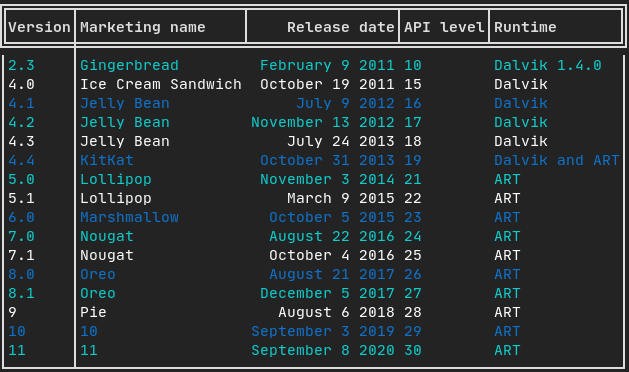
|
|||
|
|
|
|||
|
|
## Canvas {#dom-canvas}
|
|||
|
|
|
|||
|
|
See the API [<ftxui/dom/canvas.hpp>](./canvas_8hpp_source.html)
|
|||
|
|
|
|||
|
|
```cpp
|
|||
|
|
auto c = Canvas(100, 100);
|
|||
|
|
c.DrawPointLine(10, 10, 80, 10, Color::Red);
|
|||
|
|
auto element = canvas(c);
|
|||
|
|
```
|
|||
|
|
|
|||
|
|
Drawing can be performed on a `ftxui::Canvas`, using braille, block, or simple
|
|||
|
|
characters:
|
|||
|
|
|
|||
|
|
Simple [example](https://github.com/ArthurSonzogni/FTXUI/blob/master/examples/dom/canvas.cpp):
|
|||
|
|
|
|||
|
|
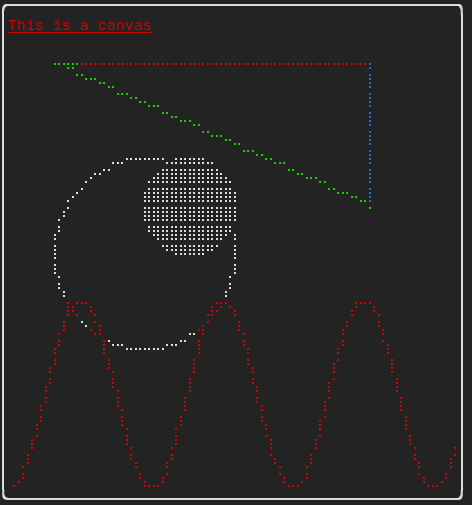
|
|||
|
|
|
|||
|
|
Complex [example](https://github.com/ArthurSonzogni/FTXUI/blob/master/examples/component/canvas_animated.cpp):
|
|||
|
|
|
|||
|
|
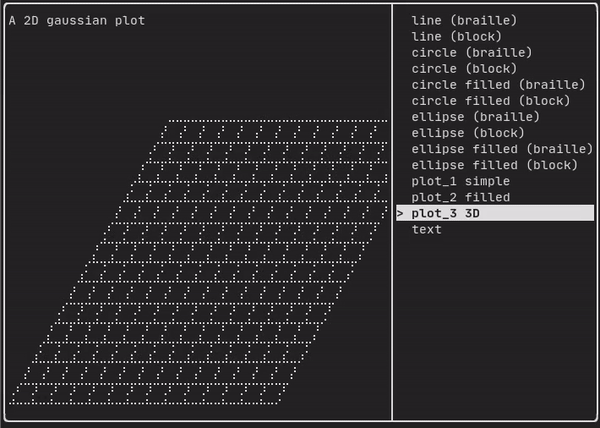
|
|||
|
|
# component {#module-component}
|
|||
|
|
|
|||
|
|
The `ftxui::component` module defines the logic that produces interactive
|
|||
|
|
components that respond to user events (keyboard, mouse, etc.).
|
|||
|
|
|
|||
|
|
A `ftxui::ScreenInteractive` defines a main loop that renders a component.
|
|||
|
|
|
|||
|
|
A `ftxui::Component` is a shared pointer to a `ftxui::ComponentBase`. The latter defines:
|
|||
|
|
- `ftxui::ComponentBase::Render()`: How to render the interface.
|
|||
|
|
- `ftxui::ComponentBase::OnEvent()`: How to react to events.
|
|||
|
|
- `ftxui::ComponentBase::Add()`: Construct a parent/child relationship
|
|||
|
|
between two components. The tree of component is used to define how to
|
|||
|
|
navigate using the keyboard.
|
|||
|
|
|
|||
|
|
`ftxui::Element` are used to render a single frame.
|
|||
|
|
|
|||
|
|
`ftxui::Component` are used to render dynamic user interface, producing multiple
|
|||
|
|
frame, and updating its state on events.
|
|||
|
|
|
|||
|
|
[Gallery](https://arthursonzogni.github.io/FTXUI/examples_2component_2gallery_8cpp-example.html) of multiple components. ([demo](https://arthursonzogni.github.io/FTXUI/examples/?file=component/gallery))
|
|||
|
|
|
|||
|
|
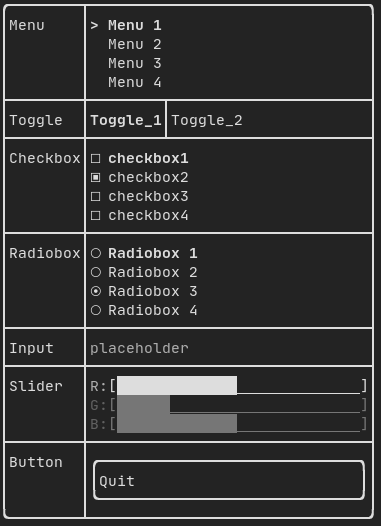
|
|||
|
|
|
|||
|
|
All predefined components are available in
|
|||
|
|
["ftxui/dom/component.hpp"](./component_8hpp.html)
|
|||
|
|
|
|||
|
|
\include ftxui/component/component.hpp
|
|||
|
|
|
|||
|
|
## Input {#component-input}
|
|||
|
|
|
|||
|
|
[Example](https://arthursonzogni.github.io/FTXUI/examples_2component_2input_8cpp-example.html):
|
|||
|
|
|
|||
|
|

|
|||
|
|
|
|||
|
|
Produced by: `ftxui::Input()` from "ftxui/component/component.hpp"
|
|||
|
|
|
|||
|
|
@htmlonly
|
|||
|
|
<script id="asciicast-223719" src="https://asciinema.org/a/223719.js" async></script>
|
|||
|
|
@endhtmlonly
|
|||
|
|
|
|||
|
|
## Menu {#component-menu}
|
|||
|
|
|
|||
|
|
Defines a menu object. It contains a list of entries, one of them is selected.
|
|||
|
|
|
|||
|
|
[Example](https://arthursonzogni.github.io/FTXUI/examples_2component_2menu_8cpp-example.html):
|
|||
|
|
|
|||
|
|

|
|||
|
|
|
|||
|
|
|
|||
|
|
Produced by: `ftxui::Menu()` from "ftxui/component/component.hpp"
|
|||
|
|
|
|||
|
|
@htmlonly
|
|||
|
|
<script id="asciicast-223720" src="https://asciinema.org/a/223720.js" async></script>
|
|||
|
|
@endhtmlonly
|
|||
|
|
|
|||
|
|
## Toggle {#component-toggle}
|
|||
|
|
|
|||
|
|
A special kind of menu. The entries are displayed horizontally.
|
|||
|
|
|
|||
|
|
[Example](https://arthursonzogni.github.io/FTXUI/examples_2component_2toggle_8cpp-example.html):
|
|||
|
|
|
|||
|
|

|
|||
|
|
|
|||
|
|
Produced by: `ftxui::Toggle()` from "ftxui/component/component.hpp"
|
|||
|
|
|
|||
|
|
@htmlonly
|
|||
|
|
<script id="asciicast-223722" src="https://asciinema.org/a/223722.js" async></script>
|
|||
|
|
@endhtmlonly
|
|||
|
|
|
|||
|
|
## CheckBox {#component-checkbox}
|
|||
|
|
|
|||
|
|
This component defines a checkbox. It is a single entry that can be turned
|
|||
|
|
on/off.
|
|||
|
|
|
|||
|
|
[Example](https://arthursonzogni.github.io/FTXUI/examples_2component_2checkbox_8cpp-example.html):
|
|||
|
|
|
|||
|
|

|
|||
|
|
|
|||
|
|
Produced by: `ftxui::Checkbox()` from "ftxui/component/component.hpp"
|
|||
|
|
|
|||
|
|
@htmlonly
|
|||
|
|
<script id="asciicast-223724" src="https://asciinema.org/a/223724.js" async></script>
|
|||
|
|
@endhtmlonly
|
|||
|
|
|
|||
|
|
## RadioBox {#component-radiobox}
|
|||
|
|
|
|||
|
|
A radiobutton component. This is a list of entries, where one can be turned on.
|
|||
|
|
|
|||
|
|
[Example](https://arthursonzogni.github.io/FTXUI/examples_2component_2radiobox_8cpp-example.html):
|
|||
|
|
|
|||
|
|

|
|||
|
|
|
|||
|
|
Produced by: `ftxui::Radiobox()` from "ftxui/component/component.hpp"
|
|||
|
|
|
|||
|
|
@htmlonly
|
|||
|
|
<script id="asciicast-223725" src="https://asciinema.org/a/223725.js" async></script>
|
|||
|
|
@endhtmlonly
|
|||
|
|
|
|||
|
|
## Dropdown {#component-dropdown}
|
|||
|
|
|
|||
|
|
A drop down menu is a component that when checked display a list of element for
|
|||
|
|
the user to select one.
|
|||
|
|
|
|||
|
|
[Example](https://arthursonzogni.github.io/FTXUI/examples_2component_2dropdown_8cpp-example.html):
|
|||
|
|
|
|||
|
|

|
|||
|
|
|
|||
|
|
Produced by: `ftxui::Dropdown()` from "ftxui/component/component.hpp"
|
|||
|
|
|
|||
|
|
## Slider {#component-slider}
|
|||
|
|
|
|||
|
|
Represents a slider object that consists of a range with binned intermediate
|
|||
|
|
intervals. It can be created by `ftxui::Slider()`.
|
|||
|
|
|
|||
|
|
[Example](https://arthursonzogni.github.io/FTXUI/examples_2component_2slider_8cpp-example.html):
|
|||
|
|
|
|||
|
|

|
|||
|
|
|
|||
|
|
Produced by: `ftxui::Slider()` from "ftxui/component/component.hpp"
|
|||
|
|
|
|||
|
|
## Renderer {#component-renderer}
|
|||
|
|
|
|||
|
|
Produced by: `ftxui::Renderer()` from \ref ftxui/component/component.hpp. This
|
|||
|
|
component decorate another one by using a different function to render an
|
|||
|
|
interface.
|
|||
|
|
|
|||
|
|
Example:
|
|||
|
|
```cpp
|
|||
|
|
auto inner = [...]
|
|||
|
|
|
|||
|
|
auto renderer = Renderer(inner, [&] {
|
|||
|
|
return inner->Render() | border
|
|||
|
|
});
|
|||
|
|
```
|
|||
|
|
|
|||
|
|
`ftxui::Renderer` also supports the component decorator pattern:
|
|||
|
|
```cpp
|
|||
|
|
auto component = [...]
|
|||
|
|
component = component
|
|||
|
|
| Renderer([](Element e) { return e | border))
|
|||
|
|
| Renderer(bold)
|
|||
|
|
```
|
|||
|
|
|
|||
|
|
As a short hand, you can also compose a component with an element decorator:
|
|||
|
|
```cpp
|
|||
|
|
auto component = [...]
|
|||
|
|
component = component | border | bold;
|
|||
|
|
```
|
|||
|
|
|
|||
|
|
## CatchEvent {#component-catchevent}
|
|||
|
|
|
|||
|
|
Produced by: `ftxui::CatchEvent()` from \ref ftxui/component/component.hpp.
|
|||
|
|
This component decorate others, catching events before the underlying component.
|
|||
|
|
|
|||
|
|
Examples:
|
|||
|
|
```cpp
|
|||
|
|
auto screen = ScreenInteractive::TerminalOutput();
|
|||
|
|
auto renderer = Renderer([] {
|
|||
|
|
return text("My interface");
|
|||
|
|
});
|
|||
|
|
auto component = CatchEvent(renderer, [&](Event event) {
|
|||
|
|
if (event == Event::Character('q')) {
|
|||
|
|
screen.ExitLoopClosure()();
|
|||
|
|
return true;
|
|||
|
|
}
|
|||
|
|
return false;
|
|||
|
|
});
|
|||
|
|
screen.Loop(component);
|
|||
|
|
```
|
|||
|
|
|
|||
|
|
The `ftxui::CatchEvent` can also be used as a decorator:
|
|||
|
|
```cpp
|
|||
|
|
component = component
|
|||
|
|
| CatchEvent(handler_1)
|
|||
|
|
| CatchEvent(handler_2)
|
|||
|
|
| CatchEvent(handler_3)
|
|||
|
|
;
|
|||
|
|
```
|
|||
|
|
|
|||
|
|
## Collapsible {#component-collapsible}
|
|||
|
|
|
|||
|
|
Useful for visual elements whose visibility can be toggle on/off by the user.
|
|||
|
|
Essentially, this the combination of the `ftxui::Checkbox()` and
|
|||
|
|
`ftxui::Maybe()` components.
|
|||
|
|
|
|||
|
|
```cpp
|
|||
|
|
auto collabsible = Collapsible("Show more", inner_element);
|
|||
|
|
```
|
|||
|
|
|
|||
|
|
## Maybe {#component-maybe}
|
|||
|
|
|
|||
|
|
Produced by: `ftxui::Maybe()` from \ref ftxui/component/component.hpp.
|
|||
|
|
This component can be utilized to show/hide any other component via a boolean or
|
|||
|
|
a predicate.
|
|||
|
|
|
|||
|
|
Example with a boolean:
|
|||
|
|
```cpp
|
|||
|
|
bool show = true;
|
|||
|
|
auto component = Renderer([]{ return "Hello World!"; });
|
|||
|
|
auto maybe_component = Maybe(component, &show)
|
|||
|
|
```
|
|||
|
|
|
|||
|
|
Example with a predicate:
|
|||
|
|
```cpp
|
|||
|
|
auto component = Renderer([]{ return "Hello World!"; });
|
|||
|
|
auto maybe_component = Maybe(component, [&] { return time > 10; })
|
|||
|
|
```
|
|||
|
|
|
|||
|
|
As usual, `ftxui::Maybe` can also be used as a decorator:
|
|||
|
|
```cpp
|
|||
|
|
component = component
|
|||
|
|
| Maybe(&a_boolean)
|
|||
|
|
| Maybe([&] { return time > 10; })
|
|||
|
|
;
|
|||
|
|
```
|
|||
|
|
|
|||
|
|
## Container {#component-container}
|
|||
|
|
|
|||
|
|
### Horizontal {#component-horizontal}
|
|||
|
|
|
|||
|
|
Produced by: `ftxui::Container::Horizontal()` from
|
|||
|
|
"ftxui/component/component.hpp". It displays a list of components horizontally
|
|||
|
|
and handle keyboard/mouse navigation.
|
|||
|
|
|
|||
|
|
### Vertical {#component-vertical}
|
|||
|
|
|
|||
|
|
Produced by: `ftxui::Container::Vertical()` from
|
|||
|
|
"ftxui/component/component.hpp". It displays a list of components vertically
|
|||
|
|
and handles keyboard/mouse navigation.
|
|||
|
|
|
|||
|
|
### Tab {#component-tab}
|
|||
|
|
|
|||
|
|
Produced by: `ftxui::Container::Tab()` from
|
|||
|
|
"ftxui/component/component.hpp". It take a list of component and display only
|
|||
|
|
one of them. This is useful for implementing a tab bar.
|
|||
|
|
|
|||
|
|
[Vertical](https://arthursonzogni.github.io/FTXUI/examples_2component_2tab_vertical_8cpp-example.html):
|
|||
|
|
|
|||
|
|

|
|||
|
|
|
|||
|
|
[Horizontal](https://arthursonzogni.github.io/FTXUI/examples_2component_2tab_horizontal_8cpp-example.html):
|
|||
|
|
|
|||
|
|
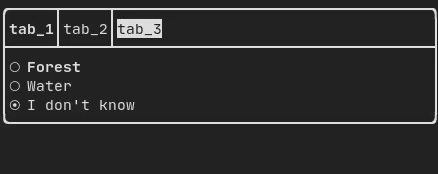
|
|||
|
|
|
|||
|
|
|
|||
|
|
## ResizableSplit {#component-resizable-split}
|
|||
|
|
|
|||
|
|
It defines a horizontal or vertical separation between two children components.
|
|||
|
|
The position of the split is variable and controllable using the mouse.
|
|||
|
|
There are four possible splits:
|
|||
|
|
- `ftxui::ResizableSplitLeft()`
|
|||
|
|
- `ftxui::ResizableSplitRight()`
|
|||
|
|
- `ftxui::ResizableSplitTop()`
|
|||
|
|
- `ftxui::ResizableSplitBottom()`
|
|||
|
|
from "ftxui/component/component.hpp"
|
|||
|
|
|
|||
|
|
[Example](https://arthursonzogni.github.io/FTXUI/examples_2component_2resizable_split_8cpp-example.html):
|
|||
|
|
|
|||
|
|
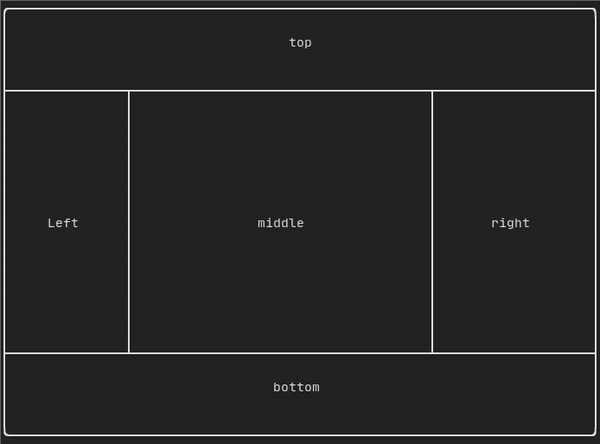
|
|||
|
|
|
|||
|
|
@htmlonly
|
|||
|
|
<script id="asciicast-tprMH2EdkUoMb7D2YxgMGgpzx" src="https://asciinema.org/a/tprMH2EdkUoMb7D2YxgMGgpzx.js" async></script>
|
|||
|
|
@endhtmlonly
|
|||
|
|
|
|||
|
|
## Force a frame redraw. {#component-force-redraw}
|
|||
|
|
|
|||
|
|
Typically, `ftxui::ScreenInteractive::Loop()` is responsible for drawing a new
|
|||
|
|
frame whenever a new group of events (e.g keyboard, mouse, window resize, etc.)
|
|||
|
|
has been processed. However, you might want to react to arbitrary events that
|
|||
|
|
are unknown to FTXUI. To accomplish this, you must post events using
|
|||
|
|
`ftxui::ScreenInteractive::PostEvent` (**this is thread safe**) via a thread.
|
|||
|
|
You will have to post the event `ftxui::Event::Custom`.
|
|||
|
|
|
|||
|
|
Example:
|
|||
|
|
```cpp
|
|||
|
|
screen->PostEvent(Event::Custom);
|
|||
|
|
```
|